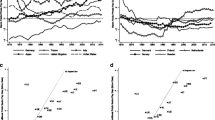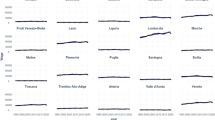Abstract
It is common wisdom that public sector wages are not determined in the same way as private sector wages. At the same time, the empirical evidence available for OECD countries finds a strong positive correlation between public and private sector wages. In this paper, we develop a model that is consistent with a political economy view of the determination of public sector wages and employment, while being consistent with the said empirical evidence. Public finance constraints are crucial: In booms, governments expand employment and wages, while in downturns, lack of tax revenues forces the government to cut back the wage bill.
Similar content being viewed by others
References
Afonso, A., & Gomes, P. (2008). Interaction between private and public sector wages. ECB Working Paper n. 971.
Agénor, P. R. (1995). The labor market and economic adjustment. IMF WP n. 95/125.
Alesina, A., Ardagna, S., Perotti, R., & Schiantarelli, F. (2002). Fiscal policy, profits and investment. American Economic Review, 92, 571–589.
Algan, Y., Cahuc, P., & Zylberberg, A. (2002). Public employment. Does it increase unemployment? Economic Policy (April), 9–65.
Allen, S. (1988). Can union labor ever cost less? NBER Working Papers n. 2019.
Ardagna, S. (2001). Fiscal policy composition, public debt and economic activity. Public Choice, 109, 301–325.
Ardagna, S. (2007). Fiscal policy in unionized labor markets. Journal of Economic Dynamics and Control, 31, 1498–1534.
Ashenfelter, O., & Ehrenberg, R. G. (1975). The demand for labor in the public sector. In D. Hamersmesh (Ed.), Labor in the public and nonprofit sectors. Princeton: Princeton University Press.
Bender, K. (1998). The central government-private sector wage differential. Journal of Economic Surveys, 12, 177–220.
Bender, K. (2003). Examining equality between public- and private-sector wage distribution. Economic Inquiry, 41, 62–79.
Blanchflower, D. (1991). Fear, unemployment and pay flexibility. Economic Journal, 101, 483–496.
Borjas, G. J. (1984). Electoral cycles and the earnings of federal bureaucrats. Economic Inquiry, 22, 447–459.
Boycko, M., Shliefer, A., & Vishny, R. (1996). A theory of privatization. Economic Journal, 106, 309–319.
Calmfors, L., & Horn, H. (1986). Employment policies and centralized wage-setting. Economica (August), 281–302.
Cavallo, M. (2005). Government employment expenditure and the effects of fiscal policy shocks. Federal Reserve Bank of San Francisco Working Paper n. 2005-16.
Chatterji, M., & Mumford, K. (2007). The public-private sector wage differential for full-time male employees in Britain: a preliminary analysis. IZA Discussion Papers n. 2781, Institute for the Study of labor (IZA).
Courant, P. N., Gramlich, E. M., & Rubinfeld, D. L. (1979). Public employee market power and the level of government spending. American Economic Review, 69, 806–817.
Demekas, D., & Kontolemis, Z. (2000). Government employment and wages and labor market performance. Oxford Bulletin of Economics and Statistics, 62, 391–415.
Domeij, D., & Ljungqvist, L. (2006). Wage structure and public sector employment: Sweden versus the United States 1970–2000. CEPR Discussion Paper n. 5921.
Ehrenberg, R. G., & Goldstein, G. S. (1975). A model of public sector wage determination. Journal of Urban Economics, 2, 223–245.
Ehrenberg, R. D., & Schwarz, J. L. (1986). Public-sector labor markets. In O. Ashenfelter & R. Leyard (Eds.), Handbook of labor economics (Vol. 2). Amsterdam: North-Holland.
Finn, M. G. (1998). Cyclical effects of government’s employment and goods purchases. International Economic Review, 39, 635–657.
Forni, L., & Giordano, R. (2003). Employment in the public sector. CESIFO Working Paper n. 1085.
Forni, L., Monteforte, L., & Sessa, L. (2009). The general equilibrium effects of fiscal policy: estimates for the euro area. Journal of Public Economics, 93, 559–585.
Freeman, R. (1986). Unionism comes to the public sector. Journal of Economic Literature, 24, 41–86.
Freeman, R. (1988a). Union density and economic performance: an analysis of U.S. States. European Economic Review, 32, 707–716.
Freeman, R. (1988b). Contraction and expansion: the divergence of private sector and public sector unionism in the United States. Journal of Economic Perspectives, 2, 63–88.
Gelb, A., Knight, J. B., & Sabot, R. H. (1991). Public sector employment, rent seeking and economic growth. Economic Journal, 101, 1186–1199.
Gomes, P. (2010). Fiscal policy and the labour market: the effects of public sector employment and wages. Mimeo, London School of Economics.
Gregory, R., & Borland, J. (1999). Recent developments in public sector labor markets. In O. Ashenfelter & D. Card (Eds.), Handbook of labor economics (Chap. 53, pp. 3573–3630). Amsterdam: Elsevier.
Holm-Hadulla, F., Kamath, K., Lamo, A., Pérez, J. J., & Schuknecht, L. (2010). Public wages in the euro area: towards securing stability and competitiveness. ECB Occasional Paper n. 112.
Holmlund, B. (1993). Wage setting in private and public sectors in a model with endogenous government behavior. European Journal of Political Economy, 9, 149–162.
Holmlund, B. (1997). Macroeconomic implications of cash limits in the public sector. Economica, 64, 49–62.
Kydland, F., & Prescott, E. (1982). Time to built and aggregate fluctuations. Econometrica, 50, 1345–1370.
Jensen, J., Sum, P., & Flynn, D. (2009). Political orientations and behavior of public employees: a cross-national comparison. Journal of Public Administration Research and Theory, 19, 709–730.
Lamo, A., Pérez, J. J., & Schuknecht, L. (2007). The cyclicality of consumption, wages and employment of the public sector in the euro area. ECB Working Paper n. 757.
Lamo, A., Pérez, J. J., & Schuknecht, L. (2008). Public and private sector wages: co-movement and causality. ECB Working Paper n. 937.
Lamo, A., Pérez, J. J., & Schuknecht, L. (2010). Public or private sector wage leadership? An international perspective. Scandinavian Journal of Economics (forthcoming).
Lane, P. (2003). The cyclical behavior of fiscal policy: evidence from the OECD. Journal of Public Economics, 87, 2661–2675.
Lindquist, M., & Vilhelmsson, R. (2006). Is the Swedish central government a wage leader? Applied Economics, 38, 1617–1625.
Malley, J., & Moutos, T. (1996). Does government employment crowd-out private employment: the Swedish case. Scandinavian Journal of Economics, 98, 289–302.
Matschke, X. (2003). Are there election cycles in wage agreements? An analysis of German public employees. Public Choice, 114, 103–135.
Moe, T. M. (1997). The positive theory of public bureaucracy. In D. Mueller (Ed.), Handbook of public choice (Chap. 21, pp. 455–480). Cambridge: Cambridge University Press.
Mueller, D. C. (2003). Public choice III. Cambridge: Cambridge University Press.
Niskanen, W. A. (1975). Bureaucrats and politicians. Journal of Law and Economics, 18, 617–643.
Niskanen, W. A. (2001). Bureaucracy. In W. Shughart II & L. Razzolini (Eds.), The Eldgar companion to public choice (Chap. 11, pp. 258–270). Cheltenham Glos: Edward Eldgar.
Oswald, A. J., Grout, P. A., & Ulph, D. T. (1984). Uncertainty, unions and the theory of public sector labor markets. Princeton University Working Paper n. 176.
Pappa, E. (2009). The effects of fiscal expansions: an international comparison. Unpublished manuscript, Universitat Autónoma de Barcelona.
Prendergast, C. (2007). The motivation and bias of bureaucrats. American Economic Review, 97, 180–196.
Quadrini, V., & Trigari, A. (2008). Public employment and the business cycle. Scandinavian Journal of Economics, 109, 723–742.
Reder, M. W. (1975). The theory of employment and wages in the public sector. In D. Hamersmesh (Ed.), Labor in the public and nonprofit sectors. Princeton: Princeton University Press.
Reid, J. D., & Kurth, M. (1988). Public employees in political firms: Part A. The patronage age. Public Choice, 59, 253–262.
Reid, J. D., & Kurth, M. (1989). Public employees in political firms: Part B. Civil service and militancy. Public Choice, 60, 41–54.
Robinson, C. (1995). Union incidence in the public and private sectors. Canadian Journal of Economics, 28, 1056–1076.
Rodrik, D. (2000). What drives public employment in developing countries? Review of Development Economics, 4, 229–243.
Schuknecht, L. (2000). Fiscal policy cycles and public expenditure in developing countries. Public Choice, 102, 115–130.
Waters, M., & Moore, W. (1990). The theory of economic regulation and public choice and the determinants of public sector bargaining legislation. Public Choice, 66, 161–175.
Author information
Authors and Affiliations
Corresponding author
Rights and permissions
About this article
Cite this article
Fernández-de-Córdoba, G., Pérez, J.J. & Torres, J.L. Public and private sector wages interactions in a general equilibrium model. Public Choice 150, 309–326 (2012). https://doi.org/10.1007/s11127-010-9705-7
Received:
Accepted:
Published:
Issue Date:
DOI: https://doi.org/10.1007/s11127-010-9705-7




